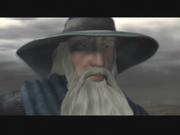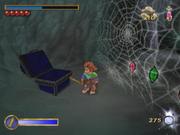In contrast to the grand scope of J. R. R. Tolkien's epic Lord of the Rings trilogy, the story of The Hobbit is the much smaller, more personal affair, chronicling the first big adventure of a reluctant young halfling by the name of Bilbo Baggins. Now, Inevitable Entertainment has woven this tale into the context of a fairly standard action adventure game. Tolkien fans may enjoy the game's presentation of Middle-earth lore, but The Hobbit tends to rely too heavily on derivative, uninspired gameplay for it to stand up on its own.

Though it regularly takes liberties with the details, the game is fairly faithful to the original story of The Hobbit. Bilbo is swept away from his comfortable hobbit hole in The Shire by an imposing wizard called Gandalf the Grey and a group of dwarves 13 strong, all of whom intend to travel to the Lonely Mountains to reclaim a dwarven treasure from a none-too-friendly dragon named Smaug. On his adventure, Bilbo runs into all manner of trolls, goblins, and giant spiders, as well as a creepy, pathetic cave-dwelling creature called Gollum, who happens to possess a very special ring. The Hobbit is an elemental tale in the genre of high fantasy, and the story elements lifted from the book are some of the strongest elements in the game.
It's apparent from the start that The Hobbit quite sincerely wishes to be an action adventure game much in the same strain as The Legend of Zelda: The Wind Waker, and its format is fairly typical for the genre. Bilbo starts off his adventure with a sack of throwing rocks and a walking stick to defend himself, but as the game progresses, he'll pick up a sword and learn some new attacks, and about halfway through the game, he'll gain the fabled One Ring, which he can use to turn himself invisible for short periods of time. The bulk of the gameplay relies heavily on action adventure staples like platform jumping, light combat, simple item-based puzzles, and a healthy amount of stealth action.
The platforming portions of The Hobbit are pretty straightforward and tend to go on for great lengths. These sections can be a bit challenging at times, mostly because the controls and the camera aren't always agreeable--though a lot of the game's bite is taken away by the liberal dispersal of save points. The combat is also pretty cut and dried. Bilbo can attack enemies from a distance by using his throwing rocks, but he's far more effective when he gets up close and personal with his glowing Elven sword. He can lock on to a single enemy easily enough when equipped with his sword, and it makes one-on-one combat a lot more manageable. But most of the time he'll be fighting a small group of enemies at once, and locking on to one enemy makes it difficult to defend against any of the other enemies.
Bilbo's assigned role of burglar within the adventure party, and the ring's ability to turn him invisible, makes the game's regular use of stealth action seem like a no-brainer. Like most stealth action, it boils down to pattern recognition and basic trial and error. Stealth action is designed to build a sense of tension, but it's all too predictable here, and in practice it ends up just being slow and boring. You'll also find plenty of treasure chests in your travels, many of which are sealed with strange, arcane locks, giving Inevitable Entertainment an excuse to implement the hottest new gameplay mechanic for 2003, the lock-picking minigame. The Hobbit's take on the lock-picking minigame tests your reflexes with a quick succession of timing-based puzzles. Ultimately, the gameplay ideas that The Hobbit is built on are perfectly serviceable, but they have all been done before, and done better.
While Peter Jackson's films based on the Lord of the Rings trilogy has popularized Middle-earth as a very dark, gritty, and rather unpleasant place to live, The Hobbit has a slightly lighter take on Tolkien's fantasy realm, and this comes across most apparently in the visuals. The game generally uses a bright, saturated color palette, which gives the world a certain vibrancy. The exaggerated character designs, the sketch drawings that appear during portions of the story exposition, and detailed environmental textures, which have a hand-painted look to them, all give the game the feel of an illustrated fantasy book for children. Indeed, this is the most kid-friendly presentation of the Tolkien universe to date--whether you'll appreciate this or not will depend on how you like your high fantasy, really. But, despite some rough enemy character models and animations, and the fairly limited size of the environments, The Hobbit is a decent-looking game.

The sound design isn't as well conceived or thought out as the visuals, though there are some highlights. The voice acting, which ranges from the Queen's English to a Scottish brogue for most of the characters, is convincing, though you may notice Gandalf's usually confident, commanding voice crack and tremble a little from time to time, and there are some peculiar bugs that make it sound like the speed of the recording is quickly ramping up. The musical score usually relies on an underplayed percussion track as you hop about on platforms and sneak your way past various trolls and elves, though it will shift to a fuller, more dangerous-sounding instrumentation when you're engaged in combat, or it will swell to a symphonic crescendo when you complete a mission task. In-game sound effects are just sort of there, with nothing standing out as terribly impressive or offensive.
With the current glut of Tolkien-inspired games focusing directly on the brutal, tragic stories of The Lord of the Rings, The Hobbit offers up a story that's less dire and more of an enjoyable romp. The story still stands up, but the game that has been wrapped around it simply cannot keep up its end of the bargain. The experience it offers just isn't as engaging or inventive as its source material.